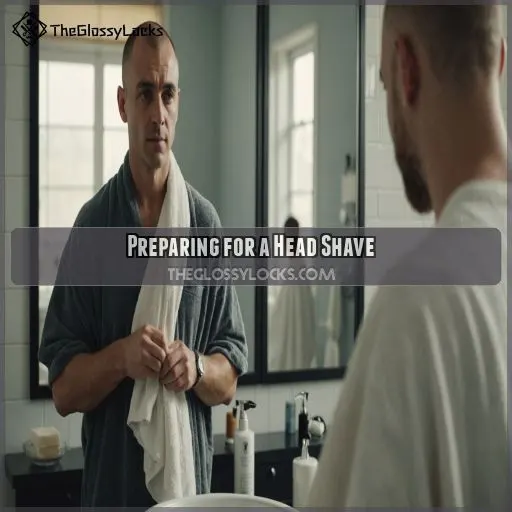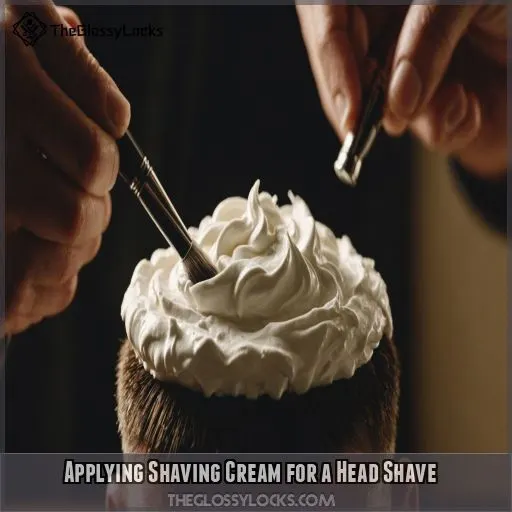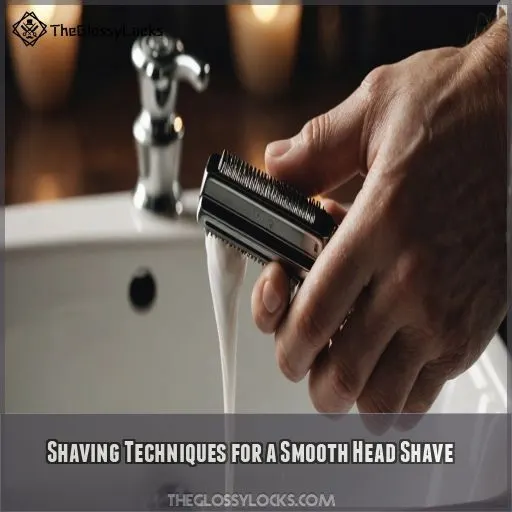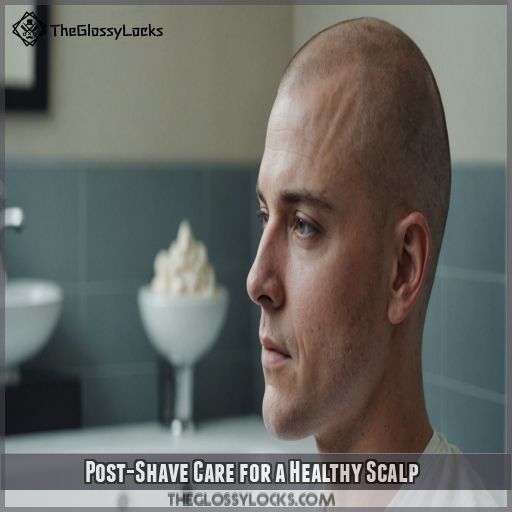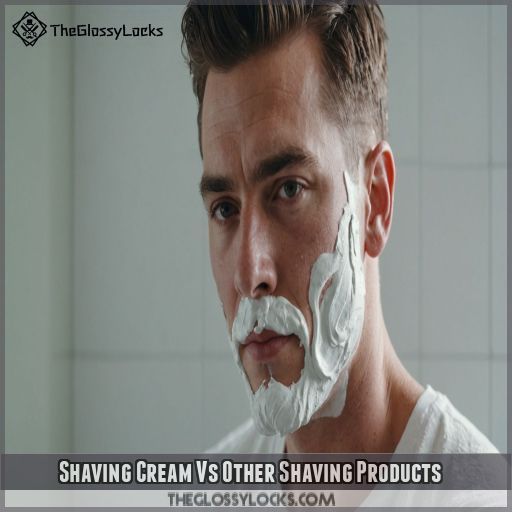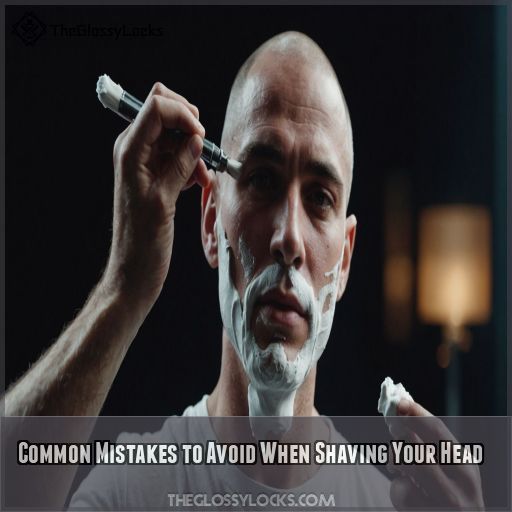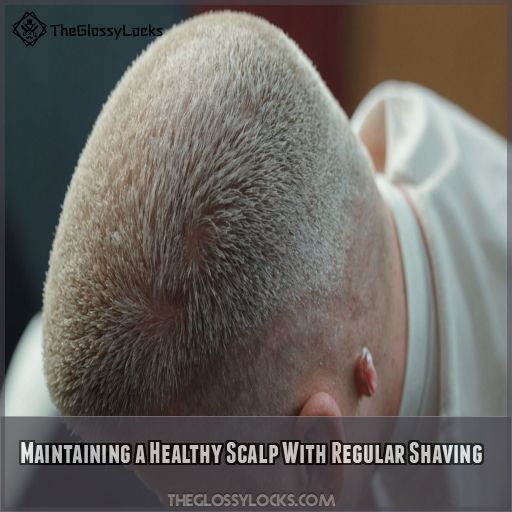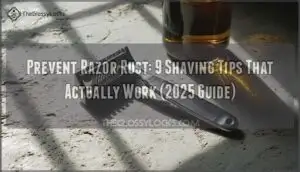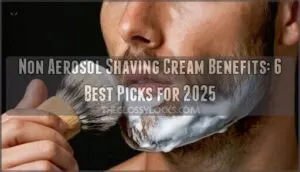This site is supported by our readers. We may earn a commission, at no cost to you, if you purchase through links.
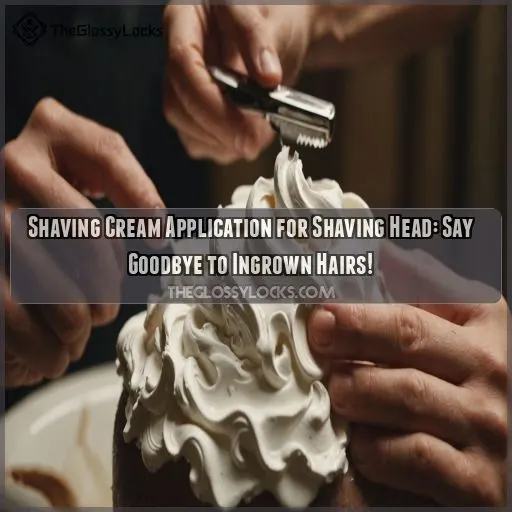 The art of shaving cream application for a silky-smooth head shave is about to be mastered. You’re on the path to making ingrown hairs a thing of the past.
The art of shaving cream application for a silky-smooth head shave is about to be mastered. You’re on the path to making ingrown hairs a thing of the past.
First, exfoliate and soften that scalp to get those hairs ready for a seamless shave. This step is crucial in preparing your scalp for the shaving process.
Next, choose a Shaving Cream with soothing ingredients like aloe vera and natural moisturizers. This will help to calm and protect your skin during the shave.
Now, here’s the magic part: lather it up and apply it with a shaving brush for an even coat. This ensures that the shaving cream is evenly distributed across your scalp, allowing for a smooth shave.
Shave with the grain, and voil! A smooth, irritation-free scalp is the result of following these simple steps.
But, there’s more to it – and we’re just getting started on the path to shaving enlightenment!
Table Of Contents
- Key Takeaways
- Preparing for a Head Shave
- Choosing the Right Shaving Cream
- Applying Shaving Cream for a Head Shave
- Shaving Techniques for a Smooth Head Shave
- Post-Shave Care for a Healthy Scalp
- Shaving Cream Vs Other Shaving Products
- Common Mistakes to Avoid When Shaving Your Head
- Maintaining a Healthy Scalp With Regular Shaving
- Frequently Asked Questions (FAQs)
- How do you shave your head with shaving cream?
- Can shaving cream be used on the head?
- Should I use shaving cream with head shaver?
- What do you put on your head before shaving?
- Can I use regular body wash as shaving cream substitute?
- How often should I reapply shaving cream while shaving head?
- Will shaving cream help reduce ingrown hairs on scalp?
- Can I use shaving cream with sensitive skin conditions like eczema?
- Are there any natural alternatives to commercial shaving creams available?
- Conclusion
Key Takeaways
- You’re about to become a master of shaving cream application for a silky-smooth head shave! To get started, exfoliate and soften your scalp to prepare your hairs for a seamless shave – it’s like giving your scalp a mini-spa treatment!
- Don’t just grab any shaving cream – choose one with soothing ingredients like aloe vera and natural moisturizers that will calm and protect your skin during the shave. Your scalp will thank you!
- Now it’s time to lather it up and apply that shaving cream like a pro! Use a shaving brush to whip up a rich lather and apply it in circular motions, making sure to cover all areas evenly. This ensures a smooth shave and helps prevent razor burn and ingrown hairs.
- You’ve got the basics down, but don’t forget the most important part: shaving with the grain! Hold your cartridge razor at a shallow angle, almost flat against your scalp, and shave in short strokes following the natural direction of hair growth. This helps the blade glide smoothly, reducing razor burn and skin irritation.
Preparing for a Head Shave
You’re about to begin a journey to a silky-smooth, hair-free head, and it all starts with preparation. Before you lather up and shave, taking a few simple steps to prep your scalp will make all the difference in achieving a comfortable, irritation-free shave.
Importance of a Shaving Routine
You’re about to start your head-shaving journey! Establishing a shaving routine is key to a smooth, irritation-free experience. By following a consistent routine, you’ll:
- Develop good habits and increase efficiency
- Achieve a closer shave over time
- Reduce shaving time and effort
- Master razor maintenance habits
- Enjoy the benefits of a well-groomed, healthy scalp (Source)
Tips for Pre-Shave Preparation
Now that you know a shaving routine is key, let’s get down to business. To prepare for a head shave, start by soaking the area in warm water for 5 minutes to open up those pores. Then, grab a warm towel and wrap it around your head to soften that stubborn hair. Time to get shaving-ready!
Exfoliating and Softening Hair
As you prep for a head shave, remember to exfoliate and soften your hair for a silky-smooth finish. Massage your scalp to increase blood flow and reduce ingrown hairs. Use exfoliating gloves or a gentle scrub to remove dead skin cells. Here are some tips to get you started:
- Scalp massage benefits: Boosts blood flow, reduces tension, and promotes healthy hair growth.
- Exfoliating gloves: Gentle, yet effective, for removing dead skin cells and softening hair.
- Softening hair tips: Soak your head in warm water for 5 minutes or apply a warm towel to open up pores.
- Pre-shave scrubs: Use a gentle, chemical-free scrub to exfoliate and prep your scalp for shaving.
Choosing the Right Shaving Cream
You’re about to discover the secret to a silky-smooth head shave: choosing the right shaving cream. By selecting a cream that’s specifically designed for sensitive skin and infused with nourishing ingredients, you’ll be saying goodbye to ingrown hairs and hello to a healthy, irritation-free scalp.
Ingredients to Look for in Shaving Cream
When choosing a shaving cream for your head, look for ingredients like aloe vera, soothing essential oils, and natural moisturizers. Avoid harsh chemicals and instead opt for anti-inflammatory ingredients and skin-nourishing extracts. These will help prevent irritation, razor burn, and ingrown hairs, leaving your scalp feeling smooth and refreshed after each shave.
Benefits of Using Shaving Cream for Head Shaves
Now that you know what to look for in a shaving cream, let’s talk about the benefits of using one for head shaves.
A good shaving cream provides a smooth shaving experience. It reduces razor burn and protects your skin from irritation.
It’s like having a personal bodyguard for your scalp, shielding it from harm and leaving you with a healthy, hair-free head.
Applying Shaving Cream for a Head Shave
You’re about to tackle the key step of applying shaving cream for a head shave – don’t worry, it’s easier than you think! With the right techniques, you’ll be on your way to a silky-smooth scalp in no time, saying goodbye to those pesky ingrown hairs for good.
How to Lather and Apply Shaving Cream
To prepare for a head shave, start by using a shaving brush to whip up a rich lather in a shaving bowl.
Apply the lather in circular motions, making sure to cover all areas evenly.
A good shaving cream should help your razor glide smoothly, preventing nicks and cuts.
When choosing a shaving cream, look for one that’s designed for sensitive skin for an extra layer of protection.
Tips for Shaving With the Grain
Time to tame the mane! When shaving with the grain, remember to hold your cartridge razor at a shallow angle, almost flat against your scalp. This helps the blade glide smoothly, reducing razor burn and skin irritation. Exfoliate your scalp beforehand to remove dead skin cells, and shave in short strokes, following the natural direction of hair growth.
Using a Shaving Brush for a Closer Shave
Now that you’re shaving with the grain, let’s talk about using a shaving brush for a closer shave. A shaving brush helps create a rich lather, exfoliates your skin, and lifts hairs for a smoother shave. Here are three benefits of using a shaving brush:
- Improved lather: A shaving brush creates a warm, rich lather that helps your razor glide smoothly.
- Exfoliating properties: The bristles gently remove dead skin cells, reducing ingrown hairs and irritation.
- Better hair lifting: The brush lifts hairs, allowing your razor to cut them cleanly and reducing razor burn.
Shaving Techniques for a Smooth Head Shave
You’re now ready to tackle the actual shaving, and with the right techniques, you’ll be on your way to a silky-smooth head. Mastering shaving techniques will also reduce irritation and ingrown hairs, while making the process more efficient, so you can get on with your day.
Shaving With a Cartridge Razor
Shaving with a cartridge razor is a great way to achieve a smooth head shave, especially for beginners. To get started, choose a razor with a pivoting head and multiple blades. Prepare your skin by exfoliating and applying a shaving gel. Shave in the direction of hair growth, using light strokes and maintaining a shallow angle.
| Cartridge Razor Types | Shaving Angle Tips | Razor Blade Care |
|---|---|---|
| Pivoting head | Shave in direction of hair growth | Change blade every 1-2 weeks |
| Fixed head | Maintain shallow angle | Clean blade with warm water |
| Multiple blades | Use light strokes | Store in dry place |
| Single blade | Avoid applying too much pressure | Handle with care |
Using a Straight or Double-Edge Razor
When using a straight or double-edge razor, control is key. Master the razor angle and stroke precision to avoid nicks and cuts.
Regular maintenance is vital, so keep your blade sharp and clean. Select the right blade for your skin type and shave with confidence.
How to Shave Hard-to-Reach Areas
Now that you’ve mastered the straight or double-edge razor, let’s tackle those tricky areas. To shave under your nose, use a gentle touch and shave with the grain. For the back of your head, use a mirror to guide you and shave in small sections. Exfoliate these areas before shaving to prevent ingrown hairs and razor burn.
Post-Shave Care for a Healthy Scalp
You’ve conquered the shave, but the real work begins now – taking care of that newly smooth scalp! In this section, we’ll walk you through the essential steps of post-shave care to keep your scalp healthy, happy, and ingrown-hair-free.
Rinsing and Drying the Scalp
The shave is done, but you’re not quite finished! Rinse your scalp with cold water to close those pores and reduce irritation. Gently pat dry with a microfiber towel – no rubbing, please! You want to prevent razor burn and irritation, not invite it to the party. A gentle touch now means a healthier scalp later.
Applying a Post-Shave Balm or Moisturizer
Now that you’ve rinsed and dried your scalp, it’s time to give it some TLC.
Apply a post-shave balm or moisturizer to soothe any irritation and lock in hydration.
Look for ingredients like aloe vera, chamomile, or lavender, which will calm and nourish your scalp.
This simple step will keep your scalp healthy and happy, making your next shave a breeze.
Tips for Preventing Razor Burn and Irritation
Preventing razor burn and irritation is a breeze with the right techniques. Here are some expert-approved tips to help you shave like a pro:
- Exfoliate your skin before shaving to remove dead skin cells
- Shave with the grain, not against it
- Use a sharp razor and change the blade frequently
- Apply a soothing post-shave balm to calm irritated skin
- Moisturize daily to keep your skin hydrated and healthy
Shaving Cream Vs Other Shaving Products
As you perfect your head-shaving routine, you’ll want to choose the right products to help you achieve a smooth, irritation-free scalp. In this section, we’ll break down the differences between shaving cream, shaving soap, gels, and foams to help you decide which one is best for your head-shaving needs.
Shaving Cream Vs Shaving Soap
In the matter of shaving your head, you’ve got options: shaving cream or shaving soap. But which one reigns supreme? Let’s break it down:
| Shaving Cream | Shaving Soap |
|---|---|
| Rich, luxurious lather | Thin, watery lather |
| Suitable for sensitive skin | Can be harsh on skin |
| Often more expensive | Generally cheaper |
Shaving cream is the clear winner for head shavers, offering a more comfortable, irritation-free experience.
Shaving Cream Vs Gels and Foams
In the matter of shaving your head, you’ve got options beyond shaving cream – gels and foams are also on the table. But, if you’ve got sensitive skin, you may want to stick with shaving cream for its higher lubrication levels and skin-soothing ingredients. Gels and foams can be more drying, and who needs that?
Common Mistakes to Avoid When Shaving Your Head
Shaving your head can be surprisingly easy to get wrong, leading to ingrown hairs, razor burn, and a whole lot of frustration. To help you achieve a smooth, irritation-free shave, let’s explore some common mistakes to avoid while shaving your head – and how a great shaving cream can make all the difference.
Shaving Against the Grain
Don’t go against the grain – literally! Shaving against the grain can lead to razor burn, ingrown hairs, and skin irritation. To avoid this, try these tips:
- Always shave in the direction of hair growth
- Use short strokes with a sharp razor
- Adjust your shaving angle to match the contours of your head
Using a Dull Razor Blade
Don’t let a dull razor blade sabotage your shaving game! A dull blade increases the risk of nicks, cuts, and razor burn. Replace your blade every 1-3 months or sooner if you notice a decline in performance. Keep your razor in top shape by rinsing it thoroughly and storing it in a dry place. Your scalp will thank you!
Not Exfoliating or Softening Hair
Don’t make the rookie mistake of not exfoliating or softening your hair before shaving! A smooth shave starts with a solid pre-shave routine. Here are four essentials to get you on track:
- Exfoliate your scalp with a gentle scrub or brush to remove dead skin cells.
- Soak your hair in warm water for 5 minutes to soften it.
- Use a warm towel to open up your pores.
- Prime your hair with a shaving cream or oil for a silky shave.
Maintaining a Healthy Scalp With Regular Shaving
As you master the art of shaving your head, maintaining a healthy scalp is vital to prevent those pesky ingrown hairs and razor burn. In this section, we’ll cover how often to shave your head, tips for preventing common issues, and the benefits of using a shaving cream with SPF for added sun protection.
How Often to Shave Your Head
Ready to rock that bald head? Maintaining a healthy scalp requires regular shaving. Shaving every 1-3 days is ideal, but adjust based on your hair growth and skin type. Create a schedule that works for you and stick to it – consistency is key! This frequency will keep ingrown hairs at bay and your scalp looking its best.
Tips for Preventing Ingrown Hairs and Razor Burn
To prevent ingrown hairs and razor burn, upgrade your scalp care routine! Exfoliate regularly to remove dead skin cells, and use a sharp razor to avoid tugging on hairs. Try a soothing shaving cream and apply a post-shave balm to calm the skin. For ingrown hair treatments, use a gentle scrub or a warm compress to ease the discomfort.
Using a Shaving Cream With SPF for Sun Protection
When shaving your head, don’t forget to protect your scalp from the sun! Using a shaving cream with SPF is a game-changer. Here are some benefits you won’t want to miss:
- Prevents premature aging and wrinkles
- Reduces risk of sunburn and skin cancer
- Soothes and moisturizes the scalp
- Helps your shaved head look healthier and smoother for longer
Frequently Asked Questions (FAQs)
How do you shave your head with shaving cream?
You’re ready to take the plunge and shave your head! Apply a rich, soothing shaving cream, like Cremo’s, in circular motions, then shave with the grain using short strokes, and voila! A smooth, liberated you!
Can shaving cream be used on the head?
You can use shaving cream on your head, but choose one specifically designed for sensitive skin to avoid irritation. Look for "soothing" or "for sensitive skin" labels, and apply it after a warm shower for a closer shave .
Should I use shaving cream with head shaver?
Coincidentally, a great shave starts with great prep! You should use shaving cream with a head shaver, as it helps the blade glide smoothly, reducing irritation and ingrown hairs. It’s a game-changer for a comfortable, close shave.
What do you put on your head before shaving?
Before shaving, prep your head by soaking it in warm water for 5 minutes, then exfoliate and soften the hair with a warm towel – it’s like giving your scalp a mini-spa treatment!
Can I use regular body wash as shaving cream substitute?
Thou shalt not sabotage thy shave!" Using regular body wash as a shaving cream substitute is a recipe for disaster. It’ll leave your skin dry, irritated, and more prone to razor burn – a painful price to pay!
How often should I reapply shaving cream while shaving head?
You’ll want to reapply shaving cream as needed, usually every 2-3 strokes, to maintain a smooth glide and prevent razor burn. Don’t be stingy – a thin layer can make all the difference in achieving a silky-smooth shave!
Will shaving cream help reduce ingrown hairs on scalp?
You can reduce ingrown hairs on your scalp by using a shaving cream specifically designed for sensitive skin . Exfoliating before shaving and shaving with the grain also helps prevent ingrown hairs .
Can I use shaving cream with sensitive skin conditions like eczema?
As you navigate the "razor’s edge" of sensitive skin, don’t worry, you can use shaving cream with eczema – just opt for a soothing, fragrance-free formula specifically designed for sensitive skin to minimize irritation.
Are there any natural alternatives to commercial shaving creams available?
You’re in luck! Natural alternatives to commercial shaving creams include coconut oil, shea butter, and olive oil. These moisturizing wonders help your razor glide smoothly while nourishing your skin – a win-win for a comfortable shave!
Conclusion
The smooth finish line is in sight. Mastering the art of shaving cream application for shaving head is the key to a silky-smooth scalp.
By exfoliating, choosing the right cream, and shaving with the grain, you’ll be saying goodbye to ingrown hairs in no time.
A well-lathered shaving cream is your best friend in this journey. With practice, you’ll be a pro at shaving cream application for shaving head, and your scalp will thank you.

